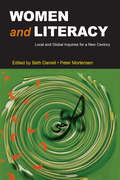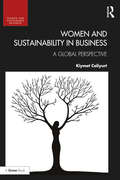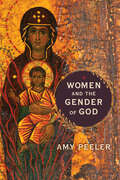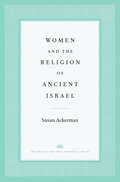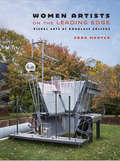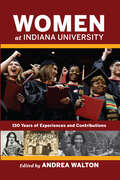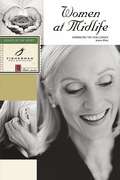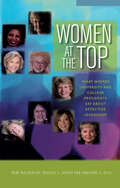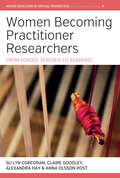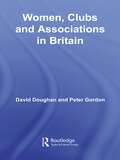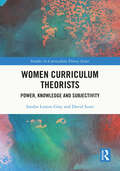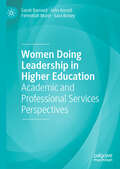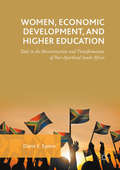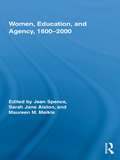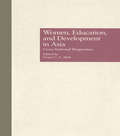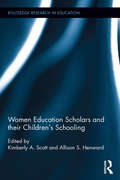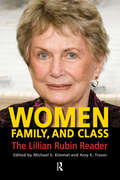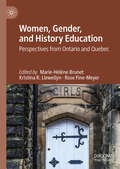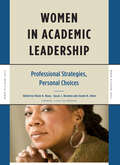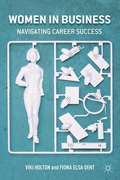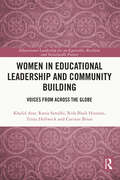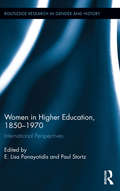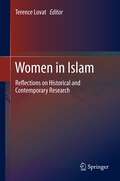- Table View
- List View
Women and Literacy: Local and Global Inquiries for a New Century (Ncte-routledge Research Ser.)
by Beth Daniell; Peter MortensenPath-breaking research on women and literacy in the past decade established conventions and advanced innovative methods that push the making of knowledge into new spheres of inquiry. Taking these accomplishments as a point of departure, this volume emphasizes the diversity—of approaches and subjects—that characterizes the next generation of research on women and literacy. It builds on and critiques scholarship in literacy studies, composition studies, rhetorical theory, gender studies, postcolonial theory, and cultural studies to open new venues for future research. Contributors discuss what literacy is—more precisely, what literacies are—but their strongest interest is in documenting and theorizing women’s lived experience of these literacies, with particular attention to:the diversity of women’s literacies within the U.S., including but not limited to the varying relations that exist among women, literacy, economic position, class, race, sexuality, and education;relations among women, literacy, and economic contexts in the U.S. and abroad, including but not limited to changes in women’s private and domestic literacies, the evolution of technologies of literacy, and women’s experience of the commodification of literacies; andemergent roles of women and literacy in a globally interdependent world. This broad, significant work is a must-read for researchers and graduate students across the fields of literacy studies, composition studies, rhetorical theory, and gender studies.
Women and Sustainability in Business: A Global Perspective (Women and Sustainable Business)
by Kiymet CaliyurtWomen and Sustainability in Business: A Global Perspective, brings together original research from a dozen countries, concerning the issues and challenges facing women in sustainable business. This is a recurrent topic among researchers, regulators, companies and rating agencies. Governments pay special attention to how women impact the economy when shaping their strategies on economic sustainability. Women’s contribution to business is fundamental to creating a sustainable economy, such that businesses try to strengthen ‘women’s presence’ within their organisations, especially on their boards. Today, sustainable companies cannot survive without strategies involving women. Stakeholders, regulators, NGOs and rating agencies track both women-focused strategies and the corporate sustainability reports of companies. Well-designed strategies for women workers help companies to develop their financial and social sustainability initiatives progressively. This book analyses the practice of women in sustainable business, in terms of company performance, social responsibility, board management, entrepreneurship, employment, education, management, social sustainability, environmental politics and technology, from a wide range of diverse, regional perspectives and highlights the differences between the underdeveloped, developing and developed world.
Women and the Economy: A Reader
by Ellen Mutari Deborah M. FigartThis reader is designed for use as a primary or supplementary text for courses on women's role in the economy. Both interdisciplinary and heterodox in its approach, it showcases feminist economic analyses that utilize insights from institutionalism as well as neoclassical economics. Including both classic and newer selections from a broad range of areas, each section includes an introduction with background material, as well as discussion questions, exercises, and lists of key terms an further readings.
Women and the Gender of God
by Amy PeelerA robust theological argument against the assumption that God is male.God values women.While many Christians would readily affirm this truth, the widely held assumption that the Bible depicts a male God persists—as it has for centuries. This misperception of Christianity not only perniciously implies that men deserve an elevated place over women but also compromises the glory of God by making God appear to be part of creation, subject to it and its categories, rather than in transcendence of it.Through a deep reading of the incarnation narratives of the New Testament and other relevant scriptural texts, Amy Peeler shows how the Bible depicts a God beyond gender and a savior who, while embodied as a man, is the unification in one person of the image of God that resides in both male and female. Peeler begins with a study of Mary and her response to the annunciation, through which it becomes clear that God empowers women and honors their agency. Then Peeler describes from a theological standpoint how the virgin birth of Jesus—the second Adam—reverses the gendered division enacted in the garden of Eden.While acknowledging the significance of the Bible&’s frequent use of &“Father&” language to represent God as a caring parent, Peeler goes beneath the surface of this metaphor to show how God is never sexualized by biblical writers or described as being physically involved in procreation—making the concept of a masculine God dubious, at best. From these doctrinal centers of Christianity, Peeler leads the way in reasserting the value of women in the church and prophetically speaking out against the destructive idolatry of masculinity.
Women and the Religion of Ancient Israel (The Anchor Yale Bible Reference Library)
by Susan AckermanA synthetic reconstruction of women&’s religious engagement and experiences in preexilic Israel &“This monumental book examines a wealth of data from the Bible, archaeology, and ancient Near Eastern texts and iconography to provide a clear, comprehensive, and compelling analysis of women&’s religious lives in preexilic times.&”—Carol Meyers, Duke University Throughout the biblical narrative, ancient Israelite religious life is dominated by male actors. When women appear, they are often seen only on the periphery: as tangential, accidental, or passive participants. However, despite their absence from the written record, they were often deeply involved in religious practice and ritual observance. In this new volume, Susan Ackerman presents a comprehensive account of ancient Israelite women&’s religious lives and experiences. She examines the various sites of their practice, including household shrines, regional sanctuaries, and national temples; the calendar of religious rituals that women observed on a weekly, monthly, and yearly basis; and their special roles in religious settings. Drawing on texts, archaeology, and material culture, and documenting the distinctions between Israelite women&’s experiences and those of their male counterparts, Ackerman reconstructs an essential picture of women&’s lived religion in ancient Israelite culture.
Women and the Transmission of Religious Knowledge in Islam
by Asma SayeedAsma Sayeed's book explores the history of women as religious scholars from the first decades of Islam through the early Ottoman period. Focusing on women's engagement with hadīth, this book analyzes dramatic chronological patterns in women's hadīth participation in terms of developments in Muslim social, intellectual and legal history. It challenges two opposing views: that Muslim women have been historically marginalized in religious education, and alternately that they have been consistently empowered thanks to early role models such as 'Ā'isha bint Abī Bakr, the wife of the Prophet Muhammad. This book is a must-read for those interested in the history of Muslim women as well as in debates about their rights in the modern world. The intersections of this history with topics in Muslim education, the development of Sunnī orthodoxies, Islamic law and hadīth studies make this work an important contribution to Muslim social and intellectual history of the early and classical eras.
Women Artists on the Leading Edge: Visual Arts at Douglass College
by Joan M. MarterHow do students develop a personal style from their instruction in a visual arts program? Women Artists on the Leading Edge explores this question as it describes the emergence of an important group of young women artists from an innovative post-war visual arts program at Douglass College. The women who studied with avant-garde artists at Douglas were among the first students in the nation to be introduced to performance art, conceptual art, Fluxus, and Pop Art. These young artists were among the first to experience new approaches to artmaking that rejected the predominant style of the 1950s: Abstract Expressionism. The New Art espoused by faculty including Robert Watts, Allan Kaprow, Roy Lichtenstein, Geoffrey Hendricks, and others advocated that art should be based on everyday life. The phrase “anything can be art” was frequently repeated in the creation of Happenings, multi-media installations, and video art. Experimental approaches to methods of creation using a remarkable range of materials were investigated by these young women. Interdisciplinary aspects of the Douglass curriculum became the basis for performances, videos, photography, and constructions. Sculpture was created using new technologies and industrial materials. The Douglass women artists included in this book were among the first to implement the message and direction of their instructors. Ultimately, the artistic careers of these young women have reflected the successful interaction of students with a cutting-edge faculty. From this BA and MFA program in the Visual Arts emerged women such as Alice Aycock. Rita Myers, Joan Snyder, Mimi Smith, and Jackie Winsor, who went on to become lifelong innovators. Camaraderie was important among the Douglass art students, and many continue to be instructors within a close circle of associates from their college years. Even before the inception of the women’s art movement of the 1970s, these women students were encouraged to pursue professional careers, and to remain independent in their approach to making art. The message of the New Art was to relate one’s art production to life itself and to personal experiences. From these directions emerged a “proto-feminist” art of great originality identified with women’s issues. The legacy of these artists can be found in radical changes in art instruction since the 1950s, the promotion of non-hierarchical approaches to media, and acceptance of conceptual art as a viable art form.
Women at Indiana University: 150 Years of Experiences and Contributions (Well House Books)
by Andrea Walton Tanner N. Terrell Dina Kellams Sarah J. Reynolds Angel Cassandra Nathan Stephanie T.X. Nguyen Merylou Rodriguez Ebelia Hernández Angela Bowen Potter Kathleen Surina Grove Nancy Van Chism Mary Giorgio Katherine Badertscher Kelly C. Sartorius Sara Clark Catherine A. Dobris Lorée B. Wilcox Rachel Jean Turner Jacob Hardesty Laurie Burns McRobbieThe first in-depth look at how women have shaped the history and legacy of Indiana University.Women first enrolled at Indiana University in 1867. In the following years they would leave an indelible mark on this Hoosier institution. However, until now their stories have been underappreciated, both on the IU campus and by historians, who have paid them little attention. Women at Indiana University draws together 15 snapshots of IU women's experiences and contributions to explore essential questions about their lives and impact. What did it mean to write the petition for women's admission or to become the first woman student at an all-male university? To be a woman of color on a predominantly white campus? To balance work, studies, and commuting, entering college as a non-traditional student? How did women contribute to their academic fields and departments? How did they tap opportunities, confront barriers, and forge networks of support to achieve their goals? Women at Indiana University not only opens the door to a more inclusive and accurate understanding of IU's past and future, but also offers greater visibility for Hoosier women in our larger understanding of women in American higher education.
Women at Midlife: Embracing the Challenges (Fisherman Bible Studyguide Series)
by Jeanie MileyMidlife is a time of transitions, some welcome and others not so welcome. Thankfully, the Bible provides principles and guidance for dealing with difficult times--midlife included. In these studies, you'll tap into that wisdom and learn how you can experience God's grace today and move forward with confidence. Whether you're struggling with the challenges of the present, mired down by mistakes in your past, or excited about the prospects of the future, you'll benefit from these important questions and life-enhancing answers for Women at Midlife.From the Trade Paperback edition.
Women at the Top: What Women University and College Presidents Say About Effective Leadership
by Mimi Wolverton Beverly L. Bower Adrienne E. HyleAlthough much has been written about leaders and leadership, we unfortunately know little about the women who fill this particular role. This book—the first in a series that explores women leaders in different contexts—remedies this gap by presenting the reflections of nine women community college, college, and university presidents on what they see as key tenets of leadership, illuminated by pivotal events in their careers.These presidents know the power of words, and in telling their stories through these interviews with the authors, they let us know who they are, what their visions are, and what they value.While they express some differences in their emphases on particular leadership characteristics, they show remarkable unanimity in their beliefs as to which are the most important—competence, credibility, and communication. The participants discuss the growing opportunities for women in higher education administration, without minimizing the barriers that still exist, nor the potential for backlash against powerful and assertive women. They stress the need for women to be very careful about making the correct choices for themselves; to balance personal life and work; and to appropriately prepare for leadership. This book both breaks new ground, and offers guidance for women who aspire to positions of leadership—in any field of endeavor. The Presidents: Gretchen M. Bataille, University of North Texas, Denton, TexasBarbara Douglass, Northwestern Connecticut Community College, Winsted, CT Mildred García, California State University, Dominguez HillsCarol C. Harter, University of Nevada, Las VegasMamie Howard-Golladay, Sullivan County Community College, Loch Sheldrake, NYMartha T. Nesbitt, Gainesville State College, Gainesville, GeorgiaPamela Sue Shockley-Zalabak, University of Colorado, Colorado SpringsBetty L. Siegel, Kennesaw State University, Kennesaw, GAKaren Gayton Swisher, Haskell Indian Nations University, Lawrence, KS Each confronts her world with grace, her work with passion, and her life with enthusiasm. The Series: Pathways to Leadership is a series about successful women who have reached the pinnacle of their careers. It features stories about extraordinary women who have found paths to success—whether it’s leading a college or university or becoming successful scholars in science and engineering or thriving in some other male-dominated arena.
Women Becoming Practitioner Researchers: From School Teacher to Academic (Higher Education in Critical Perspective: Practices and Policies #8)
by Anna Olsson Rost Su Lyn Corcoran, Claire Goodley, Alexandra HayEarly career researchers (ECRs) in education bring unique histories of professional practice and development into academic research communities. Women Becoming Practitioner Researchers explores autoethnographies of twelve women who were, or still are, schoolteachers in the process of becoming researchers. Using autoethnography to disrupt the established systems that distance researchers from their research, the chapters in this volume are curated to apply theory to this important transition. This theory as method approach provides a foundation for understanding as the authors’ weave threads of identities and experiences into their roles as practitioner researchers.
Women, Clubs and Associations in Britain (Routledge Research in Gender and History)
by Peter Gordon David DoughanWomen have been consistently excluded from all manner of clubs and associations over the years, whether as the direct result of an anti-woman policy or indirectly through prohibitive entry requirements, social constraints, or conflict of interests and tastes. Retaliation from women has taken two directions: some women have set up their own exclusive clubs that reflect their own interests and aims, while others have taken on the men and striven to break down resistance to their joining ‘men’s’ clubs on an equal footing. This book traces the development of the current situation, drawing from a wide range of sources, some of which have never been published before. Looking at the different types of clubs and associations that include women and girls from the WI to the Girl Guides, this book is a rich social history full of fascinating observations and stories, and will be absorbing reading for anyone interested in sociology, women’s history or the transformation of Britain’s social life.
Women Curriculum Theorists: Power, Knowledge and Subjectivity (Studies in Curriculum Theory Series)
by Sandra Leaton Gray David ScottMost published bodies of work relating to curriculum theory focus exclusively, or almost exclusively, on the contributions of men. This is not representative of influences on educational practices as a whole, and it is certainly not representative of educational theory generally, as women have played a significant role in framing the theory and practice of education in the past. Their contribution is at least equal to that of men, even though it may not immediately appear as visible on library shelves or lecture lists. This book addresses this egregious deficit by asking readers to engage in an intellectual conversation about the nature of women’s curriculum theory, as well as its impact on society and thought in general. It does this by examining the work of twelve women curriculum theorists: Maxine Greene, Susan Haack, Julia Kristeva, Martha Nussbaum, Nel Noddings, Jane Roland Martin, Marie Battiste, Dorothea Beale, Susan Isaacs, Maria Montessori, Mary Warnock and Lucy Diggs Slowe. The book is not an encyclopaedia, nor is it a history book. It aims to bring to the reader’s attention, through a semantic rendition of the world, those seminal relationships that exist between the three meta-concepts that are addressed in the work, feminism, learning and curriculum. It will appeal to scholars and researchers with interests in curriculum, and the philosophy and sociology of education.
Women Doing Leadership in Higher Education: Academic and Professional Services Perspectives
by Sarah Barnard John Arnold Fehmidah Munir Sara BosleyThis book outlines in-depth the findings of a five-year longitudinal mixed methods study with academic and professional services women working in higher education in the UK and the Republic of Ireland. Key themes in the book include women’s engagement in leadership, careers in higher education, work and stress, women-only leadership programmes, intersectional perspectives that shine a light on differential experiences of women and the gendered culture of higher education. The book outlines several significant implications for women working in higher education, for those managing higher education institutions (HEIs), and for those involved in higher education policy development.
Women, Economic Development, and Higher Education
by Diane E. EynonThis book is a multi-disciplinary exploration of the intersection, relationship, and connection between higher education, economic development, and gender in post-Apartheid South Africa. In just twenty years, South Africa has rewritten its constitution, restructured its macroeconomic growth and development policies, restructured its higher education system, and made a commitment to provide opportunity for all its citizens, specifically those who have historically been marginalized, women and blacks. Eynon weaves together these unique perspectives to illustrate how these multiple domains map onto women and the critical role they play in the present and future of the country. Gender equality and women's empowerment and education were considered key drivers to South Africa's transformation.
Women, Education, and Agency, 1600-2000 (Routledge Research in Gender and History)
by Jean Spence Sarah Aiston Maureen M. MeikleThis collection of essays brings together an international roster of contributors to provide historical insight into women’s agency and activism in education throughout from the seventeenth to the twentieth century. Topics discussed range from the strategies adopted by individual women to achieve a personal education and the influence of educated women upon their social environment, to the organized efforts of groups of women to pursue broader feminist goals in an educational context. The collection is designed to recover the variety of the voices of women inhabiting different geographical and social contexts while highlighting commonality and continuity with reference to creativity, achievement, and the management and transgression of structures of gender inequality.
Women, Education, and Development in Asia: Cross-National Perspectives (Reference Books in International Education #33)
by Grace C. L. MakFirst Published in 1997. Routledge is an imprint of Taylor & Francis, an informa company.
Women Education Scholars and their Children's Schooling (Routledge Research in Education)
by Kimberly Scott Allison HenwardThis volume offers both theoretical and research-based accounts from mothers in academia who must balance their own intricate knowledge of school systems, curriculum and pedagogy with their children’s education and school lives. It explores the contextual advantages and disadvantages of "knowing too much" and how this impacts children’s actions, scholastics and developing consciousness along various lines. Additionally, it allows teachers, administrators and researchers to critically examine their own discourses and those of their students to better navigate their professional and domestic roles. Gathering narratives from academic women in traditional and nontraditional maternal roles, this volume presents both contemporary and retrospective experiences of what it’s like to raise children amidst educational and sociocultural change.
Women, Family, and Class: The Lillian Rubin Reader
by Michael S. Kimmel Amy Elizabeth TraverFor more than 40 years, Lillian Rubin's work has stood as a model for the integration of the psychological and the sociological in studies of class, male-female relationships and friendships, women and aging, the sexual revolution, and the contemporary crisis of the American family. Worlds of Pain: Life in the Working-Class Family and her other books have been enormously influential. This new book brings together articles and book excerpts that reflect Rubin's revolutionary style and her distinct analytic contributions.
Women, Gender, and History Education: Perspectives from Ontario and Quebec
by Marie-Hélène Brunet Kristina R. Llewellyn Rose Fine-MeyerThis is the first edited collection to focus on women, gender, and history education in Canada. The aim of this edited collection is threefold: to offer a historical analysis of women and gender in K-12 teaching and learning of history; to provide an examination of women and gender in relation to contemporary pedagogy, curriculum, and resources in K-12 history education and teacher education; and, to explore the future of history education when informed by intersectional feminism and gender theory. Readers are introduced to the ways in which women’s historical narratives have been repeatedly marginalized, despite the efforts of feminist activists and educators. This collection is the beginning of a long overdue conversation about women and gender in how we teach and learn about the past.
Women in Academic Leadership: Professional Strategies, Personal Choices
by Diane R. Dean Susan J. Bracken Jeanie K. AllenColleges and universities benefit from diversity in their leadership roles and profess to value diversity--of thought, of experience, of person. Yet why do women remain under-represented in top academic leadership positions and in key positions along the academic career ladder?Why don’t they advance at a rate proportional to that of their male peers? How do internal and external environmental contexts still influence who enters academic leadership and who survives and thrives in those roles? Women in Academic Leadership complements its companion volumes in the Women in Academe series, provoking readers to think critically about the gendered nature of academic leadership across the spectrum of institutional types. It argues that leadership, the academy, and the nexus of academic leadership, remain gendered structures steeped in male-oriented norms and mores. Blending research and reflection, it explores the barriers and dilemmas that these structures present and the professional strategies and the personal choices women make in order to successfully surmount them. The authors pose questions about how women leaders negotiate between their public and private selves. They consider how women develop a vital sense of self-efficacy along with the essential skills and knowledge they need in order to lead effectively; how they cultivate opportunity; and how they gain legitimacy and maintain authenticity in a male-gendered arena. For those who seek to create an institutional environment conducive to equity and opportunity, this book offers insight into the pervasive barriers facing women of all colors and evidence of the need for a more complex, multi-dimensional view of leadership. For women in academe who seek to reach their professional potential and maintain authenticity, it offers encouragement and a myriad of strategies for their growth and development.
Women in Business
by Viki Holton Fiona Elsa DentMuch has been written about equal opportunity issues but little has been published about how organisations might provide more structure and support to ensure women's progress to the most senior business levels. This book looks at the career experiences of a group of women managers and consider what helps, and what still hinders their progress.
Women in Educational Leadership and Community Building: Voices from across the Globe (Educational Leadership for an Equitable, Resilient and Sustainable Future)
by Khalid Arar Rania Sawalhi Rida Blaik Hourani Trista Hollweck Corinne BrionThis book foregrounds the voices of women in educational leadership to draw on the power of diverse perspectives and to create an environment that better embraces a broad range of leadership styles. Chapters explore formal and informal female educational leadership practices, and examine the methods and approaches used by successful female leaders across West Africa, the Middle East, Europe, and Australia. The book examines how best to humanize educational leadership in a way that invests in the unique skills and talents that female leaders’ possess, and identifies a leadership model that is situated within a range of intersecting theoretical frameworks that revolve around collective leadership, transformation theories and community partnerships. In doing so, the book elevates education into the sphere of comprehensiveness, inclusion, equity, sustainability, and social justice. By sharing the lived experience of female leaders using a multi-perspective narrative approach, the book develops and hones exemplary educational leadership and community-engaged practices for the good of all. This volume will be key reading for scholars, doctoral students, and researchers engaged in fields such as education policy, women’s studies, and international and comparative education among others.
Women in Higher Education, 1850-1970: International Perspectives (Routledge Research in Gender and History)
by E. Lisa Panayotidis and Paul StortzThis edited collection illustrates the way in which women’s experiences of academe could be both contextually diverse but historically and culturally similar. It looks at both the micro (individual women and universities) and macro-level (comparative analyses among regions and countries) within regional, national, trans-national, and international contexts. The contributors integrally advance knowledge about the university in history by exploring the intersections of the lived experiences of women students and professors, practices of co-education, and intellectual and academic cultures. They also raise important questions about the complementary and multidirectional flow and exchange of academic knowledge and information among gender groups across programmes, disciplines, and universities. Historical inquiry and interpretation serve as efficacious ways with which to understand contemporary events and discourses in higher education, and more broadly in community and society. This book will provide important historical contexts for current debates about the numerical dominance and significance of women in higher education, and the tensions embedded in the gendering of specific academic programs and disciplines, and university policies, missions, and mandates.
Women in Islam
by Terence LovatThe role of women in Islamic societies, not to mention in the religion itself, is a defining issue. It is also one that remains resistant to universal dogma, with a wide range of responses to women's social roles across the Islamic world. Reflecting this heterogeneity, the editor of this volume has assembled the latest research on the issue, which combines contemporary with historical data. The material comes from around the world as well as from Muslim and non-Muslim researchers. It takes in work from majority Muslim nations such as Bangladesh, Iran, Iraq, Lebanon, Pakistan, Palestine, Tunisia and Turkey, as well as countries with troubled interfaith relations such as India and Israel. Nations with minority Muslim populations such as France, the UK, Canada and Australia, are also represented. The work also features varying Islamic sub-groups such as the two main ones, Sunni and Shi'a, as well as less well known populations such as the Ismaili Muslims. In each case, the work is underpinned by the very latest socio-theological insights and empirical data.
